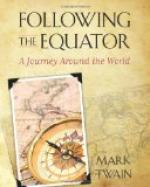After a fashion, I was able to imagine the fiery storm that raged night and day over the place during so many months, and after a fashion I could imagine the men moving through it, but I could not satisfactorily place the 200 women, and I could do nothing at all with the 250 children. I knew by Lady Inglis’ diary that the children carried on their small affairs very much as if blood and carnage and the crash and thunder of a siege were natural and proper features of nursery life, and I tried to realize it; but when her little Johnny came rushing, all excitement, through the din and smoke, shouting, “Oh, mamma, the white hen has laid an egg!” I saw that I could not do it. Johnny’s place was under the bed. I could imagine him there, because I could imagine myself there; and I think I should not have been interested in a hen that was laying an egg; my interest would have been with the parties that were laying the bombshells. I sat at dinner with one of those children in the Club’s Indian palace, and I knew that all through the siege he was perfecting his teething and learning to talk; and while to me he was the most impressive object in Lucknow after the Residency ruins, I was not able to imagine what his life had been during that tempestuous infancy of his, nor what sort of a curious surprise it must have been to him to be marched suddenly out into a strange dumb world where there wasn’t any noise, and nothing going on. He was only forty-one when I saw him, a strangely youthful link to connect the present with so ancient an episode as the Great Mutiny.
By and by we saw Cawnpore, and the open lot which was the scene of Moore’s memorable defense, and the spot on the shore of the Ganges where the massacre of the betrayed garrison occurred, and the small Indian temple whence the bugle-signal notified the assassins to fall on. This latter was a lonely spot, and silent. The sluggish river drifted by, almost currentless. It was dead low water, narrow channels with vast sandbars between, all the way across the wide bed; and the only living thing in sight was that grotesque and solemn bald-headed bird, the Adjutant, standing on his six-foot stilts, solitary on a distant bar, with his head sunk between his shoulders, thinking; thinking of his prize, I suppose—the dead Hindoo that lay awash at his feet, and whether to eat him alone or invite friends. He and his prey were a proper accent to that mournful place. They were in keeping with it, they emphasized its loneliness and its solemnity.
And we saw the scene of the slaughter of the helpless women and children, and also the costly memorial that is built over the well which contains their remains. The Black Hole of Calcutta is gone, but a more reverent age is come, and whatever remembrancer still exists of the moving and heroic sufferings and achievements of the garrisons of Lucknow and Cawnpore will be guarded and preserved.




